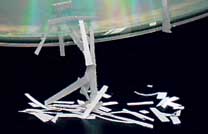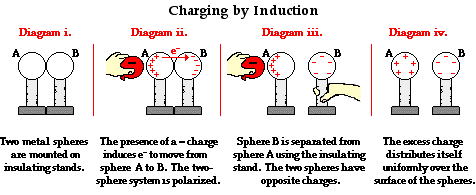Electrostatics

Electrostatics is the branch of science that deals with the study of the electric forces acting on stationary charges, and of how these forces are modi®ed in the presence of matter.
Electrostatic by friction
Insulators can transfer charge by friction.When the surface of one insulator rubs against another, electrons can be transferred.The insulator which gains electrons will get a negative charge,the insulator which loses electrons will get a positive charge.It is most important to know that it is only the negative electrons which can move.Positive charges (protons) cannot move because they are stuck inside the nuclei of the atoms of the material.
For example, if polythene (a type of plastic) is rubbed with a dry cloth, electrons are transferred from the cloth to the polythene.The polythene gains electrons and becomes negatively charged, the cloth loses electrons and becomes positively charged.
It is not possible to predict in advance which way the electrons will go for a certain material.The same cloth, when rubbed against acetate (a different type of plastic) will gain electrons and become negatively charged,
leaving the acetate with a positive charge.
Electrostatic Charge
Attraction and Repulsion.

Opposite charges attract (pull towards each other),Like charges repel (push away from each other).This means that two positively charged things will repel each other,
two negatively charged things will repel each other.One positively charged thing
and one negatively charged thing will attract each other.The further apart the charged things are, the weaker the forces of attraction and repulsion are.
Measurement of Electric Charge
Electric charge is a physical property of matter which causes it to experience a force when near other electrically charged matter.
The SI unit of quantity of electric charge is the coulomb, which is equivalent to about 6.242×1018 e (e is the charge of a proton).
Hence, the charge of an electron is approximately −1.602×10−19 C. The coulomb is defined as the quantity of charge that has passed through the cross section of an electrical conductor carrying one ampere within one second.
Insulators and Conductors
When materials are rubbed together, electrons are transferred from one material to another. The electrons that are transferred are unable to move about freely within the new material, and they remain at the surface where the material has been rubbed. Such materials where electrons are not free to move about are known as Electrical Insulators. They do not conduct electricity and are charged by friction.
On the other hand, Materials that allow electrons to move freely within them are known as Electrical Conductors. They are able to conduct electricity and are charged by induction.
Neutralising Charged Insulators and Conductors
When an object is charged, it can be neutralised by removing the excess charge from it.This process is known as discharging.
Discharging a charged insulator
One way to discharge a charged insulator is by heating it.This is because the intense heat causes the air surrounding the glass rod to be ionized. The ions in the surrounding air then neutralises the excess charges in the glass rod.
Humid condition will also neutralise a charged insulator over a period of time. This is because the water vapour in the air helps to remove excess charges on the insulator.
Discharging a charged conductor
One way to discharge a charged conductor is by earthing it. Earthing a charged conductor is to provide a path for the excess electrons to flow away or for electrons to flow to the conductor.This will cause the conductor to lose its charge and become neutral.
Charging conductors by induction
Induction charging is a method used to charge an object without actually touching the object to any other charged object.
Charging a Two-Sphere System Using a Negatively Charged Object
The metal spheres are supported by insulating stands so that any charge acquired by the spheres cannot travel to the ground. The spheres are placed side by side.
If a rubber balloon is charged negatively and brought near the spheres, electrons within the two-sphere system will be induced to move away from the balloon. This is simply the principle that like charges repel. Being charged negatively, the electrons are repelled by the negatively charged balloon. And being present in a conductor, they are free to move about the surface of the conductor.
Subsequently, there is a mass migration of electrons from sphere A to sphere B. This electron migration causes the two-sphere system to be polarized. Overall, the two-sphere system is electrically neutral. Yet the movement of electrons out of sphere A and into sphere B separates the negative charge from the positive charge.
Looking at the spheres individually, it would be accurate to say that sphere A has an overall positive charge and sphere B has an overall negative charge.
Once the two-sphere system is polarized, sphere B is physically separated from sphere A using the insulating stand. Having been pulled further from the balloon, the negative charge likely redistributes itself uniformly about sphere B.
Meanwhile, the excess positive charge on sphere A remains located near the negatively charged balloon, consistent with the principle that opposite charges attract. As the balloon is pulled away, there is a uniform distribution of charge about the surface of both spheres (see diagram iv. below). This distribution occurs as the remaining electrons in sphere A move across the surface of the sphere until the excess positive charge is uniformly distributed.

No comments:
Post a Comment